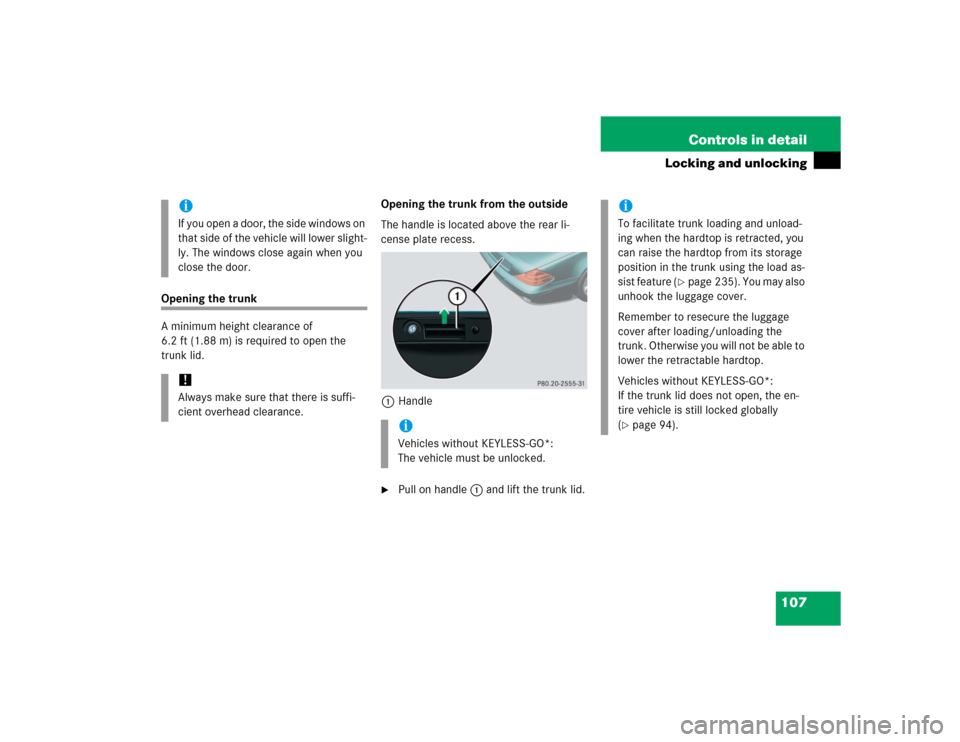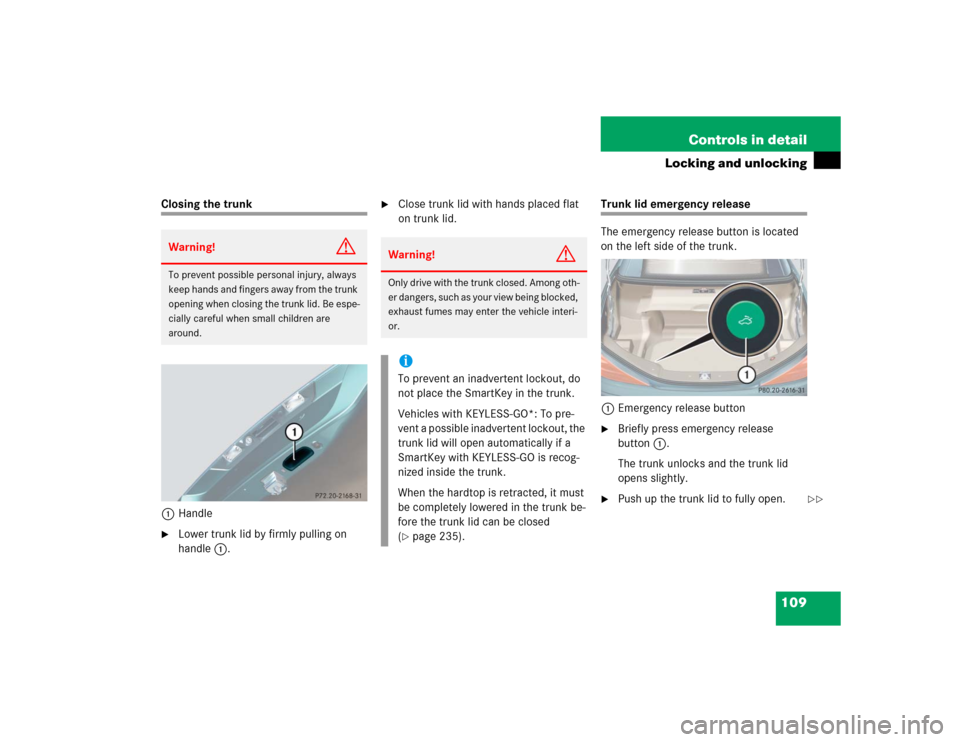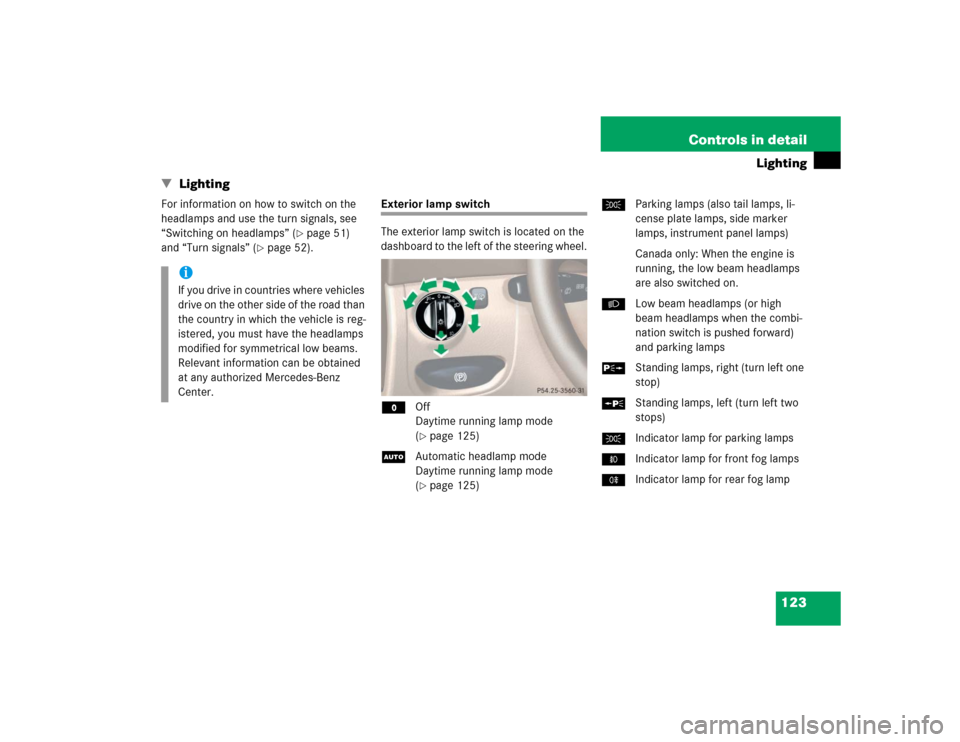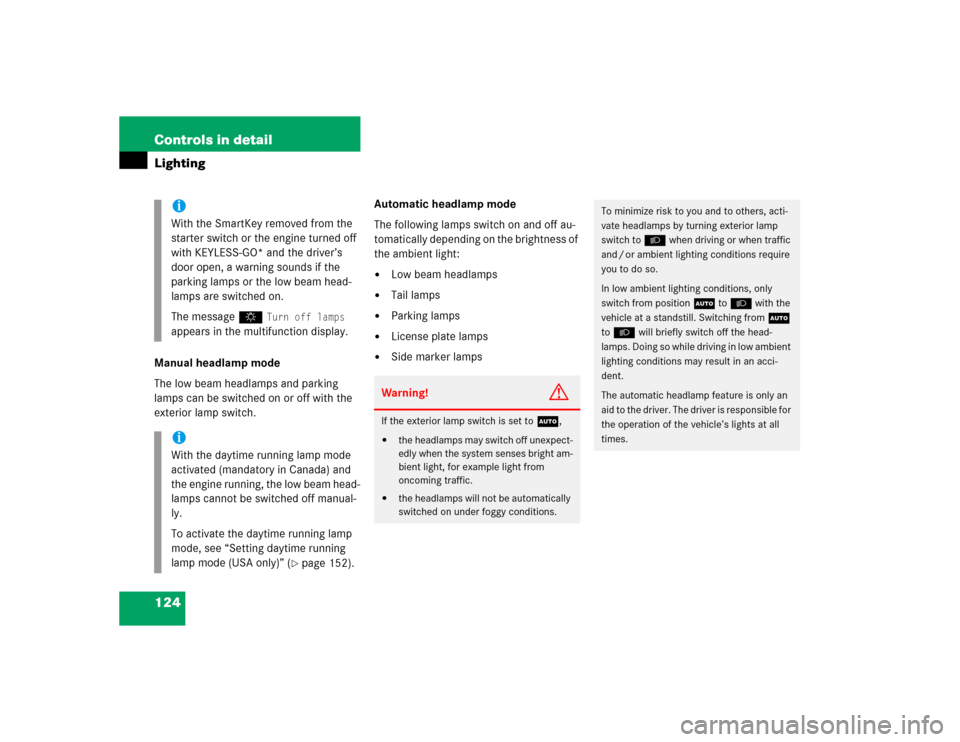Page 82 of 474

80 Safety and SecurityDriving safety systemsABS
The Antilock Brake System (ABS) regulates
the brake pressure so that the wheels do
not lock during braking. This allows you to
maintain the ability to steer your vehicle.
The ABS is functional above a speed of
approximately 5 mph (8 km/h) indepen-
dent of road surface conditions.
On slippery road surfaces, the ABS will re-
spond even to light brake pressure. The - indicator lamp in the instrument
cluster comes on when you switch on igni-
tion. It goes out when the engine is run-
ning.
Braking
If the ABS activates during braking, the
ABS/ESP warning lamp v in the instru-
ment cluster dial flashes. Because of the
SBC brake system, you will not feel any
pulsation in the brake pedal.
�
Keep firm and steady pressure on the
brake pedal.
Continuous, steady brake pedal pressure
yields the advantages provided by the ABS,
namely braking power and the ability to
steer the vehicle.The ABS/ESP warning lamp v flashes
whenever the ABS is activated which can
be an indication of hazardous road condi-
tions and functions as a reminder to take
extra care while driving.
Emergency brake maneuver
�
Keep continuous, full pressure on the
brake pedal.
Warning!
G
Do not pump the brake pedal. Use firm,
steady brake pedal pressure instead. Pump-
ing the brake pedal defeats the purpose of
the ABS and significantly reduces braking
effectiveness.
Warning!
G
When the ABS is malfunctioning, the BAS
and the ESP are also switched off.
When the ABS is malfunctioning, the wheels
may lock during hard braking, reducing
steering capability and extending the brak-
ing distance.
Page 95 of 474
93 Controls in detail
Locking and unlocking
Seats
Memory function
Lighting
Instrument cluster
Control system
Automatic transmission
Good visibility
Automatic climate control
Power windows
Retractable hardtop
Driving systems
Useful features
Page 109 of 474

107 Controls in detail
Locking and unlocking
Opening the trunk
A minimum height clearance of
6.2 ft (1.88 m) is required to open the
trunk lid.Opening the trunk from the outside
The handle is located above the rear li-
cense plate recess.
1Handle
�
Pull on handle 1 and lift the trunk lid.
iIf you open a door, the side windows on
that side of the vehicle will lower slight-
ly. The windows close again when you
close the door.!Always make sure that there is suffi-
cient overhead clearance.
iVehicles without KEYLESS-GO*:
The vehicle must be unlocked.
iTo facilitate trunk loading and unload-
ing when the hardtop is retracted, you
can raise the hardtop from its storage
position in the trunk using the load as-
sist feature (
�page 235). You may also
unhook the luggage cover.
Remember to resecure the luggage
cover after loading/unloading the
trunk. Otherwise you will not be able to
lower the retractable hardtop.
Vehicles without KEYLESS-GO*:
If the trunk lid does not open, the en-
tire vehicle is still locked globally
(
�page 94).
Page 111 of 474

109 Controls in detail
Locking and unlocking
Closing the trunk
1Handle�
Lower trunk lid by firmly pulling on
handle1.
�
Close trunk lid with hands placed flat
on trunk lid.
Trunk lid emergency release
The emergency release button is located
on the left side of the trunk.
1Emergency release button�
Briefly press emergency release
button1.
The trunk unlocks and the trunk lid
opens slightly.
�
Push up the trunk lid to fully open.
Warning!
G
To prevent possible personal injury, always
keep hands and fingers away from the trunk
opening when closing the trunk lid. Be espe-
cially careful when small children are
around.
Warning!
G
Only drive with the trunk closed. Among oth-
er dangers, such as your view being blocked,
exhaust fumes may enter the vehicle interi-
or.iTo prevent an inadvertent lockout, do
not place the SmartKey in the trunk.
Vehicles with KEYLESS-GO*: To pre-
vent a possible inadvertent lockout, the
trunk lid will open automatically if a
SmartKey with KEYLESS-GO is recog-
nized inside the trunk.
When the hardtop is retracted, it must
be completely lowered in the trunk be-
fore the trunk lid can be closed
(�page 235).
��
Page 125 of 474

123 Controls in detail
Lighting
� Lighting
For information on how to switch on the
headlamps and use the turn signals, see
“Switching on headlamps” (
�page 51)
and “Turn signals” (
�page 52).
Exterior lamp switch
The exterior lamp switch is located on the
dashboard to the left of the steering wheel.
MOff
Daytime running lamp mode
(
�page 125)
UAutomatic headlamp mode
Daytime running lamp mode
(�page 125)CParking lamps (also tail lamps, li-
cense plate lamps, side marker
lamps, instrument panel lamps)
Canada only: When the engine is
running, the low beam headlamps
are also switched on.
BLow beam headlamps (or high
beam headlamps when the combi-
nation switch is pushed forward)
and parking lamps
ˆStanding lamps, right (turn left one
stop)
‚Standing lamps, left (turn left two
stops)
CIndicator lamp for parking lamps
‡Indicator lamp for front fog lamps
†Indicator lamp for rear fog lamp
iIf you drive in countries where vehicles
drive on the other side of the road than
the country in which the vehicle is reg-
istered, you must have the headlamps
modified for symmetrical low beams.
Relevant information can be obtained
at any authorized Mercedes-Benz
Center.
Page 126 of 474

124 Controls in detailLightingManual headlamp mode
The low beam headlamps and parking
lamps can be switched on or off with the
exterior lamp switch.Automatic headlamp mode
The following lamps switch on and off au-
tomatically depending on the brightness of
the ambient light:
�
Low beam headlamps
�
Tail lamps
�
Parking lamps
�
License plate lamps
�
Side marker lamps
iWith the SmartKey removed from the
starter switch or the engine turned off
with KEYLESS-GO* and the driver’s
door open, a warning sounds if the
parking lamps or the low beam head-
lamps are switched on.
The message $
Turn off lamps
appears in the multifunction display.
iWith the daytime running lamp mode
activated (mandatory in Canada) and
the engine running, the low beam head-
lamps cannot be switched off manual-
ly.
To activate the daytime running lamp
mode, see “Setting daytime running
lamp mode (USA only)” (
�page 152).
Warning!
G
If the exterior lamp switch is set toU,�
the headlamps may switch off unexpect-
edly when the system senses bright am-
bient light, for example light from
oncoming traffic.
�
the headlamps will not be automatically
switched on under foggy conditions.
To minimize risk to you and to others, acti-
vate headlamps by turning exterior lamp
switch to B when driving or when traffic
and / or ambient lighting conditions require
you to do so.
In low ambient lighting conditions, only
switch from position U to B with the
vehicle at a standstill. Switching from U
to B will briefly switch off the head-
lamps. Doing so while driving in low ambient
lighting conditions may result in an acci-
dent.
The automatic headlamp feature is only an
aid to the driver. The driver is responsible for
the operation of the vehicle’s lights at all
times.
Page 127 of 474

125 Controls in detail
Lighting
�
Turn the exterior lamp switch to posi-
tion U.
With the SmartKey in starter switch
position1 or the KEYLESS-GO
start/stop button pressed once, only
the parking lamps will switch on and off
automatically.
When the engine is running, the low
beam headlamps, the tail and parking
lamps, the license plate lamps, and the
side marker lamps will switch on and
off automatically.Daytime running lamp mode
�
Turn the exterior lamp switch to
positionM orU.
When the engine is running, the low
beam headlamps are switched on auto-
matically.
In low ambient light conditions, the fol-
lowing lamps will switch on additional-
ly:�
Tail lamps
�
Parking lamps
�
License plate lamps
�
Side marker lampsFor nighttime driving you should turn the
exterior lamp switch to positionB to
permit activation of the high beam head-
lamps.
iThe fog lamps cannot be switched on
with the exterior lamp switch in posi-
tion U. To switch on the fog lamps,
turn the exterior lamp switch to posi-
tion B.
iWith the daytime running lamp mode
activated and the exterior lamp switch
in positionM, the highbeam head-
lamps cannot be switched on.
The highbeam flasher is available at all
times.
Page 128 of 474

126 Controls in detailLightingCanada only:
The daytime running lamp mode is manda-
tory and therefore in a constant mode.
When the engine is running and you shift
from a driving position to positionN orP,
the low beam headlamps will switch off
with a three-minute delay.
When the engine is running and you�
turn the exterior lamp switch to posi-
tion C, the parking lamps switch on
additionally
�
turn the exterior lamp switch to posi-
tion B, the manual headlamp mode
has priority over the daytime running
lamp mode
The corresponding exterior lamps
switch on (
�page 123).USA only:
By default, the daytime running lamp mode
is deactivated. Activate the daytime run-
ning lamp mode using the control system,
see “Setting daytime running lamp mode
(USA only)” (
�page 152).
The high beam headlamps can also be ac-
tivated when driving with the daytime run-
ning lamp mode activated and the exterior
lamp switch in positionM.
When the engine is running and you turn
the exterior lamp switch to positionC
or B, the manual headlamp mode has
priority over the daytime running lamp
mode.
The corresponding exterior lamps switch
on (
�page 123).Locator lighting and night security
illumination
Locator lighting and night security illumi-
nation are described in the control system
section, see “Setting locator lighting”
(
�page 153) and “Setting night security il-
lumination” (
�page 154).